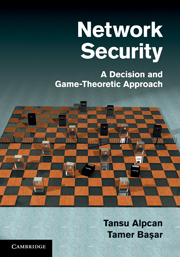A - Optimization, game theory, and optimal and robust control
Published online by Cambridge University Press: 02 December 2010
Summary
This appendix provides some background material on those aspects of optimization, game theory, and optimal and robust control theory which are frequently used in the text. It also serves to introduce the reader to our notation and terminology. For more detailed expositions on the topics covered here, standard references are for game theory, for optimal control, and for robust (H∞) control.
Introduction to optimization
We discuss in this section elements of and some key results from optimization in finite-dimensional spaces, including nonlinear, convex and linear programming, and distributed computation. Before we do this, however, it will be useful to introduce the notions of sets, spaces, norms, and functionals, which are building blocks of a theory of optimization.
Sets, spaces, and norms
A set S is a collection of elements. If s is a member (element) of S, we write s ∈ S; if s does not belong to S, we write s ∈ S. If S contains a finite number of elements, it is called a finite set; otherwise it is called an infinite set. If the number of elements of an infinite set is countable (i.e. if there is a one-to-one correspondence between its elements and positive integers), we say that it is a denumerable (countable) set, otherwise it is a nondenumerable (uncountable) set.
Information
- Type
- Chapter
- Information
- Network SecurityA Decision and Game-Theoretic Approach, pp. 274 - 301Publisher: Cambridge University PressPrint publication year: 2010
